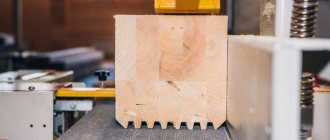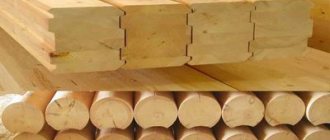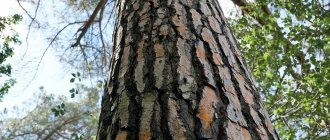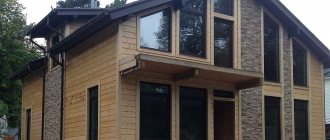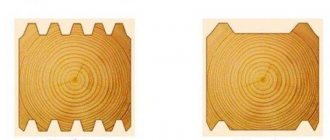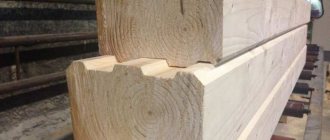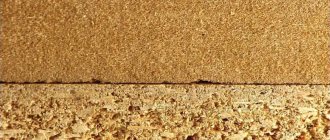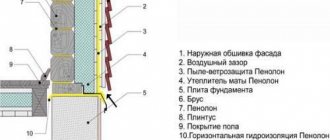Wood in construction is an excellent material that many people like, including me. I love wooden houses and constantly use panels when covering rooms. At the same time, more than once I wondered how lining differs from imitation timber, and what material is better to use. It turned out to be easy to figure out, since imitation timber is one of the types of lining. The differences lay in some details.
Source infradom.ru
Features of imitation timber
Imitation timber belongs to the group of planed lumber. Products can have a surface width from 65 to 200 mm and a length of up to 6 meters. These sizes are very convenient for finishing the facades of wooden buildings. The ease of installation of the material allows it to cover surfaces of any configuration.
Among the advantages of this type of product (photo below):
- Wide availability and relatively low cost of the material. You can buy it in any region of the country.
- Environmental Safety . Various types of wood are used in the production of the material. Modern processing technologies make it possible to paint product panels in any color. This makes their appearance more presentable.
- Versatility . The panels can be used to finish surfaces made of any materials.
- Easy to install . Finishing the surface of walls or ceilings with imitation timber does not require heavy physical effort or special equipment. The panels are connected using the tongue-and-groove method. The entire structure is mounted on a wooden sheathing, which allows you to place a layer of insulation between the finishing panels and the wall.
- Wear resistance . The material withstands temperature changes well. With additional treatment with antiseptics, the imitation timber increases resistance to moisture, fungi and mold. The service life of the material depends on the type of wood chosen for its production and can reach from 15 to 25 years without additional processing.
- High level of heat and noise insulation.
The material acts as a finishing coating in premises of any purpose. To increase the service life of the panels, wax solutions and protective oils are used.
This type of wood processing allows you to protect products from exposure to ultraviolet rays and preserve their original appearance for a long time.
Among the disadvantages of the material:
- Increased fire hazard. The panels require special treatment with agents that reduce the likelihood of fire.
- Tendency to rot and dry out.
IMPORTANT!
It is not recommended to use materials with high humidity in finishing any surfaces.
To avoid deformation of the imitation timber during operation, use a dry board with a humidity of 10-12%.
Classification
Lumber is produced in several grades. The grade is determined by the quality of processing of the front surface of the panels, the structure of the wood, the type of wood, and the correctness of the profile geometry.
“Calm” lining is produced in the following grades:
- Extra;
- Prima;
- A;
- AB, BC.
Extra
This class is assigned to panels without defects. VS of the “Extra” class has no cracks, chips, bends or rotten knots. The profile is made by splicing several boards. Due to this, the front surface of the lining is smooth. The highest grade VSh is considered elite, which is reflected in its high price. Products are delivered to the retail chain in vacuum packaging.
Prima
Prima lining is made from larch. Lumber is used for cladding facades. The boards are durable and can withstand sudden temperature changes. The façade, lined with Prima, creates an imitation of wall finishing with profiled timber. Larch panels cover the interior surfaces of residential premises.
A
Class “A” lining is a 1st grade product. From different manufacturers, grade 1 VSh is in no way inferior in quality to “Extra” class panels. Technical production conditions allow for subtle cracks with a length of no more than 90 mm, light knots with a diameter of no more than 15 mm.
AB, BC
Lining of classes “AB”, “BC” with reduced material quality requirements are rejected boards of the highest grades or products made from low-quality wood. Typically, lumber is used for cladding walls and ceilings in utility rooms.
Advantages and disadvantages of lining
Wooden lining is produced from coniferous and deciduous wood. The main direction of use of the material is interior decoration of premises for various purposes.
Lining has found its application in interior design in the following styles:
- Scandinavian. In finishing it is used together with stone and timber.
- Provencal. The surface of the lining is covered with paint, which is matched to the tone of the plastered walls.
- High tech. In interior design it is used in combination with metal.
- Country. Reminiscent of Russian rustic style, in which the original appearance of the lining is preserved when decorating the walls.
- Loft. Provides a combination of different types of decoration.
The advantages of lining are similar to imitation timber. Among them:
- Environmentally friendly.
- Availability.
- Versatility.
- Easy to install.
Wooden lining contributes to the formation of a healthy microclimate in the premises . In winter they are always warm and dry. Among the disadvantages of the material: susceptibility to rotting processes and increased fire hazard. To improve the performance properties of the lining, it is subjected to additional processing. For this purpose, special impregnations and moisture-proof varnishes are used.
NOTE!
Processing the lining with special means allows not only to improve the consumer properties of the material, but also to improve its appearance.
The low cost of this material makes it accessible to a wide range of buyers.
How to install lining
It is advisable to install the material according to the fastening diagram; this will make installation quick and simple. In addition to the wood itself, you will also need insulation, for example, mineral wool, which should be placed under the sheathing, maintaining the integrity of the sheet.
- The bars themselves are covered with glassine.
- The boards need to be secured in the grooves, especially if you are doing the work with your own hands without professional skills.
The lining can be arranged in various ways, depending on your wishes. However, it is worth considering that, for example, a vertical arrangement can lengthen the height of the room, while a horizontal arrangement will make an overly large room more comfortable.
At the same time, choosing a wood tone that is too light can make a cramped room feel more spacious, regardless of the placement of the panels.
Below are short installation instructions that include all the main steps:
- The work begins with the sheathing, which in turn is based in the corner. A 2 mm hole is drilled in the ridge, having previously selected the places where the sheathing is located. Each element will be attached to it.
- The wooden panel must be laid with a groove towards the edge.
- The self-tapping screw is inserted into the hole in the ridge, after which it screws the panel to the sheathing.
- The second board is applied to the sheathing and carefully pushed with a comb into the groove with the adjacent one, already fixed.
- To get a tight fit of one lining element to another, you should knock it down a little with a mallet.
- A hole for a self-tapping screw should be drilled in the second board, which will allow it to be fixed.
What is the difference between lining and imitation timber?
A large number of people do not understand the fundamental difference between products and consider imitation timber to be one of the types of lining. The similarity of products ends with the purpose of the material and the raw materials used for its production.
Imitation timber is much thicker than lining. The range of its thickness is from 16 to 37 mm. The lining is produced in thicknesses up to 16 mm.
IMPORTANT!
Products that are thick are used for exterior decoration of house walls and their pediments.
The surface width of the false beam should not be less than 110 mm. A narrower surface will not be able to fulfill its main purpose - to imitate the surface of a timber . Another important distinguishing feature of product panels is the installation of lamellas.
The lining can be installed horizontally, vertically and diagonally. Imitation timber is installed only horizontally.
Differences
The main differences are due to different characteristics:
- Dimensions . The imitation timber is thicker and wider. Thanks to this, this material is more resistant to weather conditions and impacts.
- The lining can be mounted in any direction - horizontally, vertically and diagonally. The beam is designed for horizontal installation.
- The surface of the timber is more embossed , slightly polished, while that of the lining is smooth.
- The variety of lining types offered is wider . You can make a simple wall or decorate it with a decorative profile.
What is the best way to cladding building facades?
In finishing the facades of wooden housing construction, one can find in practice the use of both imitation timber and lining. The choice of material depends on the taste preferences of the owner of the building and his financial capabilities.
Imitation timber is best suited for cladding the facades of wooden and frame houses. It is more resistant to environmental influences.
When purchasing material, preference is given to products with a humidity of 10-14%. Higher rates cause deformation of products when they dry in the sun.
A special groove is made on the outside of the imitation timber panel. It is designed to relieve the tension of the product when drying, remove excess moisture when “sweating” at home and for ventilation . According to current standards, all imitation timber produced by manufacturers is divided into grades. For exterior finishing, it is better to use grade A panels. Such products do not have fallen knots, wormholes or cracks on their surface. Their locking connection must have mechanical damage.
Regular and eurolining
The lining owes its name to the need to protect goods from sun and rain that were transported by rail before the introduction of modern materials. The use of wood for lining carriages was the most appropriate, since it is not only cheaper than iron, but also better prevents the greenhouse effect.
Initially, the boards were fastened in the usual way, but over time, to simplify installation and prevent the appearance of cracks in case of any deformation, they began to be made with tongue-and-groove locks. The idea was appreciated and such boards began to be widely used in facing work.
In other languages, there is no such connection to the origin of the name, so when visiting foreign construction stores you should simply look for profiled boards. For their manufacture, the DIN 68126/86 standard is used, developed in Europe and, according to a number of requirements, is more stringent than the local GOST. Accordingly, products exported or simply manufactured according to DIN standards are familiar to domestic buyers as Eurolining.
Builders make a large number of complaints about ordinary lining, made according to Soviet standards, both in terms of characteristics and ease of installation. Humidity of 20-25% is too high - with a board thickness of 20 mm, deformations often occur during drying, which small locks cannot cope with, trying to jump out of the groove
The fleecy surface and the number of knots, which are not particularly controlled, make not only the shape, but also the quality of such products unimportant
Profile of a standard lining manufactured in accordance with GOST.
As a result, eurolining, despite the price, is much more readily used by builders due to its advantages:
- A more thoughtful shape: a large tenon is not afraid of deformation, optimal thickness and width of the lamellas (12.5 and 88 (without the tenon, with it – 96) mm, respectively), the presence of ventilation grooves, the ability to choose a profile pattern.
- No lint is allowed on the front side, careful processing of the tongue and groove lock for ease of installation.
- All eurolining is dried to a moisture content of 10-15%, which negates the possibility of its deformation and the likelihood of bugs or rot. Dry boards are easier to store, process and care for during use.
- After cutting the wood, the boards, depending on their quality, are divided into at least four grades, taking into account manufacturing defects and the condition of the wood itself.
Which material is best for interior decoration?
Lining can be used for finishing facades or interior spaces. The purpose of the usual type of this material is internal lining of walls and ceilings . Panels made from deciduous trees are used to cover walls in baths and saunas.
When heated, the lining made from hardwood does not emit essential oils that can cause poisoning to the human body.
Manufactured products may have different profile shapes and lock sizes. The most common is the classic eurolining. It is characterized by an angular shape and an increased spine size. Softline lining panels have more rounded shapes.
In turn, imitation timber is used to finish the floor.
What to choose: “Calm” lining or imitation timber?
Calm lining and imitation timber have their advantages and disadvantages. Each product has its own purpose. Calm lining is not much different from other types of this group of products . It can be used for covering walls and ceilings indoors, as well as for facade work.
An important advantage of imitation for external work is its thickness. This material is more resistant to the external environment. The surface of its panels is perfect for painting or varnishing.
When choosing a finishing material, you need to pay attention not only to the appearance of the products, but also to the condition of their locks. The panel tenons should fit easily into the grooves. The material should not show signs of rotting, chips or cracks. The optimal humidity of the panels is 12-14%.
What is lining
Before examining the differences between lining and imitation timber, it is worth learning more about these materials.
Lining is a finishing material, a thin cladding board that has a tongue-and-groove joint. This allows the boards to firmly adhere and obtain a smooth surface, without cracks or gaps. There are several profile options:
- Standard : has a trapezoidal cross-section with beveled corners at 30 degrees;
- " Calm ": characterized by rounded corners;
- Europrofile : has a wider tenon, up to 8 mm, which allows for higher strength;
- Eurolining : the grooves are deeper, in addition, quite strict requirements apply to eurolining;
- “ American ”: has a beveled profile, which makes it possible to overlap the lining on the wall.
There are other types. They differ in appearance: the “blockhouse” has a rounded front part, the “landhouse” creates a whole pattern.
The material is used for finishing indoors and outdoors, for living rooms and technical rooms, baths and saunas, loggias, balconies, utility rooms.
Source prom.st
Initially, the lining was made of natural wood. It has a number of advantages:
- The material is environmentally friendly. Some types of lining, for example, made from coniferous wood, have medicinal properties;
- It is strong and durable, looks in almost any interior;
- The lining is characterized by high heat capacity and good sound insulation properties;
- Air passes through it well, which allows the room to “breathe”;
- When using special impregnations, the lining perfectly resists rotting and pests;
- It is characterized by simple installation and ease of replacement of a separate board;
- Wood retains its color and texture for a long time, retains the aroma of wood (this is especially noticeable in saunas and baths);
- Depending on the material, lining can be quite affordable.
These advantages apply only to lining made of natural wood. Today the material is also made from plastic and MDF. Their only advantage is ease of assembly due to convenient connection.
Source domoholic.ru
The disadvantages of lining include:
- Fire hazard;
- Low moisture resistance, which can cause the material to deform. It can be solved by purchasing high-quality lining with the necessary impregnations;
- Drying out. Over time, the tree decreases in size. To prevent this from happening, you need to buy chamber-drying lining.
Raw materials for production
For production, well-dried oak blanks are used. Sawing, grinding, and turning the lock take place at normal humidity in a warm room, which prevents bending or twisting of the wood during processing.
Oak is a very hard, expensive, beautiful wood. The cut has a beautiful pattern, the density of the wood practically eliminates damage to the surface by physical or thermal effects.
Premium class Shtil lining is produced at several factories in Russia, and it is also imported from other countries. The high price per unit of lamella is justified by the high strength characteristics. Even when stored in warehouses with unsatisfactory conditions, the sheets retain their shape and appearance.



